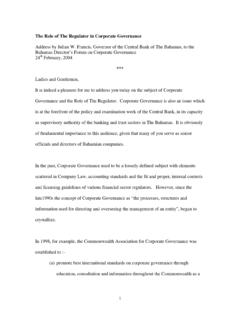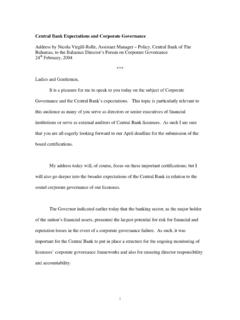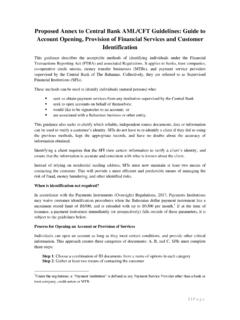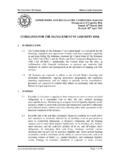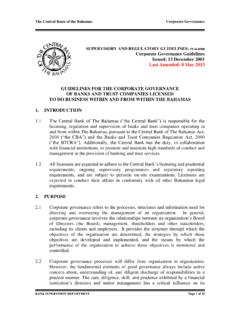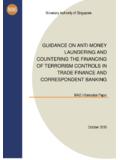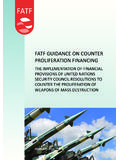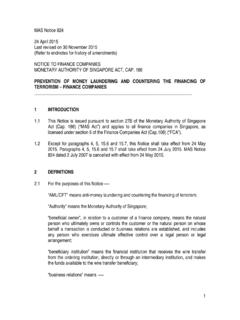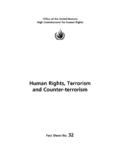Transcription of AML/CFT GUIDELINES Date Issued: May 1, 2009 Last …
1 AML/CFT GUIDELINES Date Issued: May 1, 2009 Last Revised: May 31, 2017 The Central Bank of The Bahamas GUIDELINES FOR SUPERVISED FINANCIAL INSTITUTIONS ON THE PREVENTION OF MONEY LAUNDERING & countering THE FINANCING OF TERRORISM The Central Bank of The Bahamas The Bank Supervision Department Frederick Street Nassau, Bahamas Telephone: 242-302-2615 Facsimile: 242-356-39092 TABLE OF CONTENTS PAGES SCOPE 5 SECTION I BACKGROUND 7 Bahamian Anti-Money Laundering and Anti-Terrorism Legislative Framework 7 Penalties for Non-Compliance 7 What is Money Laundering? 7 The Need to Prevent Money Laundering 8 Stages of Money Laundering 8 Vulnerability of Supervised Financial Institutions to Money Laundering Laundering 9 Tipping Off 9 Terrorism and Terrorist Financing 9 Interpretation 10 Responsibilities of the Central Bank 11 SECTION II INTERNAL CONTROLS, POLICIES & PROCEDURES 12 SECTION III RISK RATING CUSTOMERS 14 International Standards 14 Developing a Risk Rating Framework 14 Prospective Customers 16 Existing Customers 16 SECTION IV VERIFICATION OF CUSTOMER IDENTITY 16 Nature and Scope of Activity 17 Who should SFIs Verify and when should Identity be Verified?
2 18 Facility Holder 18 IDENTIFICATION PROCEDURES 19 A. Natural Persons 19 A1. Confirmation of Name and Address 19 A2. When is Further Verification of Identity Necessary? 21 A3. Persons Without Standard Identification Documentation 22 A4. Certification of Identification Documents 23 B. Corporate Clients 24 C. Segregated Accounts Companies 26 D. Powers of Attorney 276 E. Partnerships/Unincorporated Businesses 27 F. Financial and Corporate Service Providers 28 3 G. Other Legal Structures and Fiduciary Arrangements 28 H. Identification of New Trustees 30 I. Foundations 311 J. Executorship Accounts 31 K. Non-profit Associations (Including Charities) 324 L. Products & Services Requiring Special Consideration 32 (a) Provision of Safe Custody and Safety Deposit Boxes 33 (b) New Products, Practices and Technological Developments 33 (c) Intermediaries 33 (d) Occasional Transactions 34 RELIANCE ON THIRD PARTIES TO CONDUCT KYC ON CUSTOMERS 35 Introductions from Group Companies or Intermediaries 35 SIMPLIFIED DUE DILIGENCE 37 A.
3 Bahamian or Foreign Financial Institutions 37 B. Occasional Transactions: Single or Linked 37 C. Exempted Clients 37 ENHANCED DUE DILIGENCE 38 A. Transactions by Non Face-to-Face Customers 39 B. Correspondent Relationships 41 C. Politically Exposed Persons 42 D. High-Risk Countries 45 E. Bearer Shares 45 TREATMENT OF BUSINESS RELATIONSHIPS EXISTING PRIOR TO 29TH DECEMBER, 2000 46 ON-GOING MONITORING OF BUSINESS RELATIONSHIPS 47 Monitoring 47 Hold Mail Accounts 482 SECTION V MONEY TRANSMISSION BUSINESSES 48 Vulnerability of MTBs to Money Laundering & Terrorist Financing 49 Identification Documentation 50 Transaction Monitoring 50 Indicators of the Misuse of MTBs 50 SECTION VI ELECTRONIC FUNDS TRANSFERS 52 Pre-conditions for Making Funds Transfers Verification of Identity of Payers 52 Monitoring Wire Transfers for Sanctioned Persons, Entities or Countries/Jurisdictions 52 CENTRAL BANK OF THE BAHAMAS SUPERVISORY AND REGULATORY GUIDELINES May 31, 2017 PREVENTION OF MONEY LAUNDERING AND countering THE FINANCING OF TERRORISM 4 Cross-border Wire Transfers of Below $1,000 - Reduced Payer Information 53 Cross-border Wire Transfers of $1.
4 000 or More - Complete Payer and Payee Information 53 Domestic Wire Transfers - Reduced Payer Information 54 Batch File Transfers 545 Wire Transfers via Intermediaries 5489 Technical Limitations 55 Duty to Assess Risks 55 Minimum Standards 55 Record Keeping Requirements 55 Beneficiary Financial Institutions - Checking Incoming Wire Transfers 56 Exemptions 57 Card Transactions 57 Offences and Fines 58 SECTION VII RECORD KEEPING 58 Verification of Identity and Other Records 58 Transaction Records 59 Records Related to ongoing investigations and suspicious activity 60 Format of Records 61 SECTION VIII THE ROLE OF THE MONEY LAUNDERING REPORTING OFFICER 61 SECTION IX EDUCATION AND TRAINING 62 Requirements 62 The Need for Staff Awareness 62 Identifying Suspicion 62 Reporting Procedures 63 Education and Training Programmes 63 APPENDICES PAGES A Summary of Existing Bahamian Law 65 B Relevant Web-sites 89 C Anti-Money Laundering Flowchart Summary of Identification Checks 90 D Countries Listed In The First Schedule Of The Financial Transactions Reporting Act, 2000 91 E Definition of Financial Institution 92 CENTRAL BANK OF THE BAHAMAS SUPERVISORY AND REGULATORY GUIDELINES May 31, 2017 PREVENTION OF MONEY LAUNDERING AND countering THE FINANCING OF TERRORISM 5 SCOPE The Central Bank of The Bahamas ( the Central Bank ) is responsible for the licensing, registration, regulation and supervision of supervised financial institutions ( SFIs ) operating in and from within The Bahamas pursuant to the Banks and Trust Companies Regulation Act, 2000 ( BTCRA ), the Central Bank of The Bahamas Act, 2000, and The Bahamas Cooperative Credit Unions Act, 2015 ( BCCUA ).
5 Additionally, the Central Bank has the duty, in collaboration with its SFIs, to promote and maintain high standards of conduct and management in the provision of banking and trust services. All SFIs are expected to adhere to the Central Bank s licensing, registration and prudential requirements and ongoing supervisory programmes, including periodic onsite examinations, and required regulatory reporting. SFIs are also expected to conduct their affairs in conformity with all other Bahamian legal requirements. The BTCRA directs the Inspector of Banks and Trust Companies ( the Inspector ) to ensure that SFIs have in place strict Know-Your-Customer ( KYC ) rules that promote high ethical and professional standards, and so prevent use of SFIs for criminal purposes. The Inspector is required to ensure effective offsite supervision of SFIs and is empowered to conduct onsite examinations for the purpose of satisfying himself that the provisions of, inter alia, the Financial Transactions Reporting Act, 2000 and the Regulations made thereunder are being complied with.
6 These GUIDELINES incorporate both the mandatory minimum requirements of the AML/CFT laws of The Bahamas and industry best practices and replace those which were initially issued by the Central Bank to SFIs in October 2005. These GUIDELINES also replace the Anti-Money Laundering and Anti-Terrorist Financing Handbook and Code of Practice GUIDELINES for Credit Unions on the Prevention of Money Laundering and countering the Financing of Terrorism, initially issued by the Compliance Commission to credit unions in October 2013. It is, therefore, expected that all SFIs of the Central Bank pay due regard to these GUIDELINES in developing responsible procedures suitable to their business to prevent money laundering and terrorist financing. If an SFI appears not to be doing so the Central Bank will seek an explanation and may conclude that the SFI is carrying on business in a manner that may give rise to sanctions under the applicable legislation.
7 It is important that the management of every SFI view money laundering prevention and countering the financing of terrorism as part of their risk management strategies and not simply as a stand-alone requirement that is being imposed by the legislation. Money laundering prevention and countering the financing of terrorism should not be viewed in isolation from a SFIs other business systems and needs. These GUIDELINES have been prepared in consultation with those financial institutions and industry organisations that expressed an interest in being consulted in the course of the development of these GUIDELINES . The scope of these GUIDELINES covers all mainstream fiduciary, banking, lending and deposit taking activities of Central Bank Licensees. Where a SFI is a part of an international group, it shall follow the group policy to the extent that all overseas branches, subsidiaries and associates where control can be exercised, ensure CENTRAL BANK OF THE BAHAMAS SUPERVISORY AND REGULATORY GUIDELINES May 31, 2017 PREVENTION OF MONEY LAUNDERING AND countering THE FINANCING OF TERRORISM 6 that anti-money laundering prevention and countering the financing of terrorism standards and practices are undertaken at least to the standards required under Bahamian law or, if standards in the host country are considered or deemed more rigorous, to those higher standards.
8 Reporting procedures for suspicious transaction reports ( STR s ) and the offences to which the anti-money laundering and anti-terrorism legislation in The Bahamas relates must be adhered to in accordance with Bahamian laws and practices. The Financial Intelligence Unit ( the FIU initially issued GUIDELINES in 2001 which covered anti-money laundering policies and procedures as well as requirements for suspicious transactions reporting. In 2007, the FIU updated its GUIDELINES to encompass matters related to the financing of terrorism, but with a narrower focus on the processes related to Suspicious Transactions Reporting (STRs). Accordingly, SFIs should continue to adhere to the FIU s GUIDELINES insofar as they relate to suspicious transactions reporting. There is a risk that efforts to detect money laundering or to counter the financing of terrorism and to trace the assets will be impeded by the use of alternative undetected channels for the flow of illegal funds consequent on an automatic cessation of business (because an SFI suspected that funds stemmed from illegal activity).)
9 To avoid that risk, SFIs should report their suspicions to the FIU and obtain their own independent legal advice as to whether or not they should continue the business relationship or transaction. In carrying out transactions where a SFI is considering making a STR, the SFI should consider duties owed to third parties such as in the case of a constructive trustee. In such cases, it is recommended that independent legal advice is sought. Consistent with the requirements of the law these GUIDELINES cover:- Internal controls, policies and procedures (Section II); Risk Rating Customers (Section III); Verification of Customer Identity (Section IV); Money Transmission Businesses (Section V); Electronic Funds Transfers (VI); Record Keeping (Section VII); The Role of the Money Laundering Reporting Officer ( MLRO ) (Section VIII); and Education and training (Section IX).CENTRAL BANK OF THE BAHAMAS SUPERVISORY AND REGULATORY GUIDELINES May 31, 2017 PREVENTION OF MONEY LAUNDERING AND countering THE FINANCING OF TERRORISM 7 I - BACKGROUND Bahamian Anti-Money Laundering and Anti-Terrorism Legislative Framework 1 The law of The Bahamas specifically concerning money laundering and terrorist financing is contained in the following legislation: the Proceeds of Crime Act, 2000 ( POCA ) (as amended); the Anti-Terrorism Act, 2004 (as amended); the Financial Transactions Reporting Act, 2000 (as amended) ( FTRA ); the Financial Transactions Reporting Regulations, 2000 (as amended) ( FTRR ); the Financial Transactions Reporting (Wire Transfers) Regulations, 2015; the Financial Intelligence Unit Act, 2000 (as amended) ( FIUA ); and the Financial Intelligence (Transactions Reporting) Regulations, 2001 (as amended).
10 2 Summaries of the legislation are set out in Appendix A. Penalties for Non-Compliance 3 SFIs should be aware that there are a number of offences which arise from failing to comply with certain obligations imposed under the Acts listed above and the Regulations made pursuant to these Acts. SFIs should also note that revisions have been effected to the laws which allow for the imposition of criminal prosecution and/or penalties. In particular, under the FIUA and The Financial Intelligence (Transactions Reporting) Regulations, where a financial institution fails to comply with the requirements of GUIDELINES issued by the FIU or the Central Bank, these penalties can range from a fine of $10,000 on summary conviction or $50,000 for a first offence and $100,000 for any subsequent offence on conviction in the Supreme Court. SFIs should also be aware that the Central Bank also has authority under the Financial Transactions Reporting (Wire Transfers) Regulations, to impose civil penalties of up to $2,000 for non-compliance with those laws and with these GUIDELINES .

